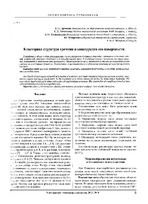| dc.contributor.author | Гречихин, Л. И. | ru |
| dc.contributor.author | Латушкина, С. Д. | ru |
| dc.contributor.author | Комаровская, В. М. | ru |
| dc.contributor.author | Шмермбекк, Ю. | ru |
| dc.coverage.spatial | Москва | ru |
| dc.date.accessioned | 2019-10-24T13:28:28Z | |
| dc.date.available | 2019-10-24T13:28:28Z | |
| dc.date.issued | 2015 | |
| dc.identifier.citation | Кластерная структура кремния и конструкция его поверхности / Л. И. Гречихин [и др.] // Упрочняющие технологии и покрытия. – Москва : Машиностроение, 2015. – № 9. – С. 5-10. | ru |
| dc.identifier.uri | https://rep.bntu.by/handle/data/58254 | |
| dc.description.abstract | Разработана общая модель формирования молекулярных и кластерных структур с учетом ковалентной, ионной, наведенной, электрон-дипольной и диполь-дипольной связи. В конденсированном состоянии кластеры кремния формируются трехатомными молекулами. Межкластерная связь определяется бинарным взаимодействием сцепленных кластерных структур. Теоретически и экспериментально обоснована конструкция кристаллического кремния. | ru |
| dc.language.iso | ru | ru |
| dc.publisher | Машиностроение | ru |
| dc.title | Кластерная структура кремния и конструкция его поверхности | ru |
| dc.type | Article | ru |
| local.description.annotation | One has developed a general model offormation o f molecular and cluster structures taking into account covalent, ionic, electron-dipole and dipole-dipole bond. In the condensed state silicon clusters are formed by three-atomic molecules. The inter-cluster bond is defined by binary interaction of coupled cluster structures. The construction o f crystalline silicon has been substantiated theoretically and experimentally. | ru |

